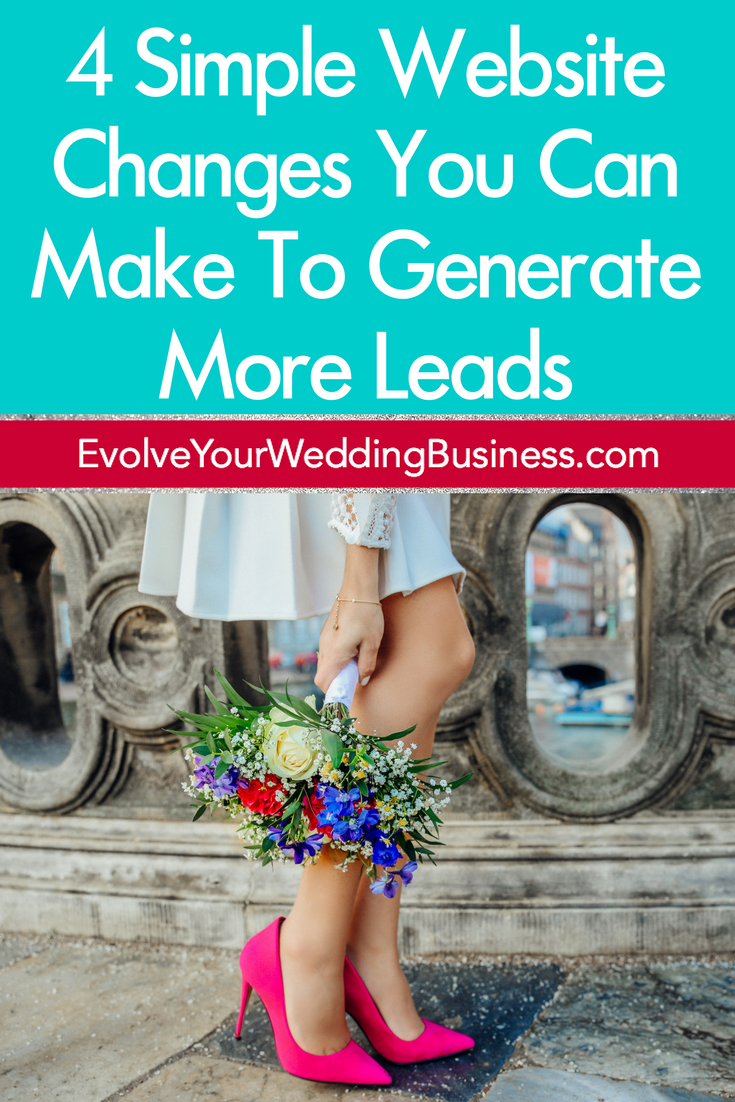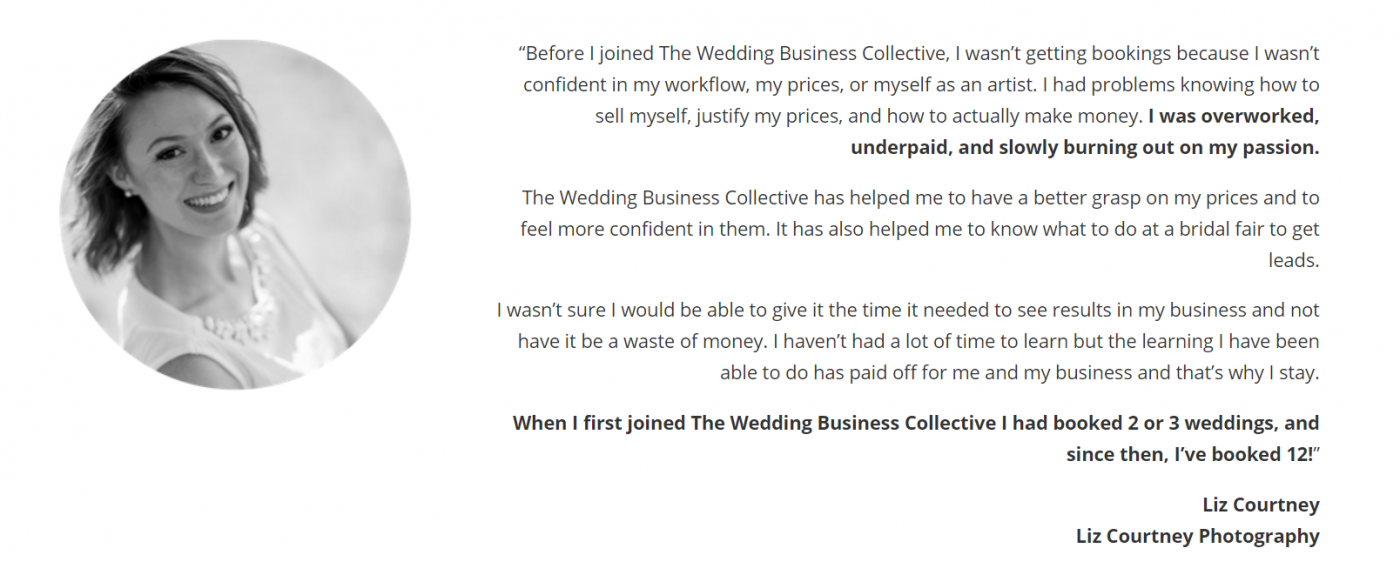Some people call me an OG of wedding business marketing, but deep down I'm just another person wearing PJ bottoms on Zoom. I swear a lot, I share my struggles, and I don't pretend to be better than anyone else.
a marketing and business nerd who fell in love with the wedding industry.
Hi, I’m Heidi
4 Simple Website Changes You Can Make To Generate More Leads

It can be overwhelming to think about all of the things you could improve in your business. If you’re anything like me, you have a never ending to-do list that somehow seems to just keep growing. I’ve got good news for you: sometimes making improvements can be simple and easy. Here are 4 simple things you can do to improve your wedding business website so it generates more leads for you.
1. Optimize what’s already working
This is my favorite kind of improvement to make because it’s so easy and just cranks things up on what’s already working. In order to see which of your pages/posts are bringing in the most traffic, dig into your Google Analytics. If you don’t have Google Analytics set up on your site, or if you just want to learn more about how to get more valuable info out of it, this is for you.
Within Google Analytics, you can see which pages/posts have had the highest number of visits for any period of time. I like to set the date range for the past year to get a good idea of what is consistently popular. Look at your top 10 pages/posts and ask yourself these questions:
- Could you add a clearer call to action to these pages/posts?
- Could you add an email opt-in to these pages/posts so that you can continue to market to this visitor via email marketing?
- If it’s a blog post, the topic clearly resonated. What content could you create that would likely be popular based on what you already have?
- If it’s page, could you improve the copy?
- Could you optimize the images for SEO so that you rank higher in Google for the topic?
- Could you add any internal links to improve your SEO?
- Are there any hidden opportunities within your Google Analytics that you may be missing?
Action: If you don’t already use Google Analytics, set it up today! If you do, look at those top 10 pages/posts and go through these 7 questions.
2. Add calls to action
When someone reads your blog posts, website content or marketing materials, do they know what you want them to do next? This might seem silly but it is statistically proven that using calls to action (CTAs) increases the likelihood of a visitor taking a specific action.
Calls to action are simply words that are used to get your prospect to take a specific action like “click here” or “sign up”. They could be buttons or links but they exist purely to get the person to take a specific action.
Action: Take a look at every page on your own website and think about what action you want the reader to take after they read it.
3. Improve your copy
In The Wedding Business Collective, I do a Member Makeover each month where I record my screen as I go through one member’s website. I can’t tell you how many times I’ve seen pricing/packages pages that are too feature focused and effectively turn the wedding pro into a commodity. Maybe you have one of these pages on your site. It lists the things that come with the package and a price.
If you are listing your prices on your website without any context to the benefits that your customers get, you’re the one focusing on price. It only makes sense that people will focus on price because you’ve made your packages page about the price and not the value of what you offer or the results you’re delivering. So instead of putting the focus on price, you need to put the focus on the benefits of your particular product or service.
Have you ever gone to the store and thought “I’ll buy this floor cleaner because I really like floor cleaners!”? I certainly hope not! People buy cleaning products so that they can have a clean house and you can go even deeper into why someone wants a clean house. I saw a commercial in the UK for a toilet cleaner that insisted your guests are judging you based on how clean your toilet is. I thought it was odd because I would hope my friends aren’t that shallow, but I couldn’t deny that it was brilliant because it spoke people who want to impress their guests. The product is just the vehicle to get them to their destination. They’re not buying a cleaning product, they’re buying the ability to impress their guests.
What is your customer’s destination?
You’ll need to know the difference between features and benefits in order to implement this so here are some definitions:
A feature is what your product or service has. For wedding planners, this includes hours a client gets with you, checklists, budgets, vendor recommendations, etc. For photographers, features include the number of hours of coverage, an engagement session, how many pages the album will be, etc.
A benefit is what those features mean to your customer. How do the features benefit them? Maybe you save them time, money or stress. Your customer doesn’t know that from reading how many hours they get with you, they only know that when you tell them that is what they get.
Features speak to the logical part of our brains, but not the emotional part. That is what we need benefits for. In order to figure out what the benefit is for each feature, you have to ask “so what?” from your client’s perspective. It might be helpful to do this with someone you trust instead of doing it alone.
Here’s an example:
A wedding photographer might say “This package includes 8 hours of coverage”….so what?
So they have photos of the entire wedding day……so what?
So they know their wedding photos will showcase their entire day……..so what?
So they can look back on the album years from now and laugh at that photo we captured of their dad busting out his amazing 70s dance moves.
Bingo! That level of specificity allows your potential client to imagine themselves experiencing the benefit and not wanting to miss out on it.
You can either just use the benefit in your copy or use the feature and the benefit with “so that” in between. Here that would be “This package includes 8 hours of coverage so when your dad decides to get funky with his dance moves, we’re there to capture those memories for you to look back on for years”. Doesn’t that sound so much more enticing than just selling the feature?
How can you make the language that you use more enticing and easier to understand?
Action: Take some time today to review your website, particularly your pricing/packages page, and think about how you can go from something no one understands to something people can get excited about.
4. Add more social proof
Have you had styled shoots featured on blogs or in magazines? Showcase those logos proudly in an “As Seen On” box on your site! Those logos provide social proof.
Social proof is a psychological phenomenon we all experience when we see that someone is trusted by others and you begin to trust them too. It’s sort of the positive version of guilt by association.
There have been studies that demonstrate the power of social proof including one from the Washington Post that showed that positive social proof was actually more influential than saving money.
This is why every McDonald’s sign says “Billions and billions served”. Knowing that billions of people have had something is reassuring to the part of us that likes to avoid risk. If you’ve ever made a decision based on an Amazon review by a total stranger, you’ve acted because of social proof. If you’ve ever been impressed that someone has been featured on a particular blog or magazine, that’s social proof at work.
Displaying where you’ve been featured isn’t the only way to build credibility through social proof. Your testimonials play a HUGE role in this but not just any testimonial will do the trick. I see a lot of bland testimonials that say things like “She was great!” or “We’re so happy we worked with you”. That only gives you a tiny piece of the story. If you want your testimonials to help you make more sales they have to describe the experience of the customer before, during and after working with you. You have to tell their story, their full story.
Here is an example of a testimonial I have from a client that shows the before, during and after.
This gives a much different feeling to the reader than something like “Heidi was great and I loved working with her”. You can identify with the feels of the person before, during and after working with me. That is exactly the type of testimonial that will help you get more clients.
Take these 4 actions today and you’ll be well on your way to a webinar that generates more leads for you!
Still Paying for The Knot or WeddingWire (Even Though They Stopped Working)?
Discover the proven roadmap wedding pros use to replace outdated platforms and finally attract inquiries that lead to bookings.
Leave a Reply Cancel reply
Based in San Diego, California / working with wedding businesses worldwide
